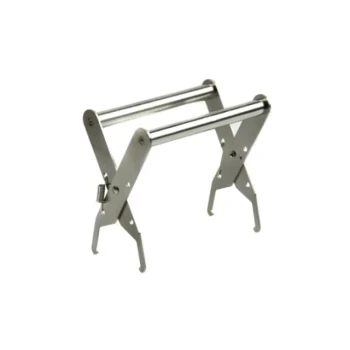At its core, the preference is about efficiency and instinct. Bees prefer foundationless frames because the solid barrier of a foundation sheet physically interferes with their natural comb-building process, known as festooning. This forces them to work less efficiently, expending more time and energy to build two separate comb structures on either side of the foundation.
The central issue is that a sheet of foundation, while helpful to the beekeeper, creates an unnatural obstacle for the bees. Foundationless frames remove this barrier, allowing bees to build a single, cohesive honeycomb in the most energy-efficient way their instincts have perfected.

The Core Reason: Unrestricted Comb Building
To understand the preference, you have to understand how bees naturally build comb. It's a marvel of biological engineering that foundation fundamentally alters.
The Behavior of Festooning
When bees are ready to build comb, they consume large amounts of nectar or honey and secrete beeswax from glands on their abdomens.
They then link their legs together, hanging in intricate chains or curtains that form a living scaffold. This behavior is called festooning.
How Foundation Creates a Barrier
A sheet of foundation placed in the middle of a frame acts as a wall. It splits the bees' living scaffold into two separate groups.
Instead of one cohesive festoon, the bees must form two smaller, independent festoons—one on each side of the foundation.
The Efficiency of Natural Building
Without foundation, the bees can form a single, large festoon that hangs down from the top bar of the frame.
From this unified scaffold, they work together to build a single, continuous comb from the top down. This is a more direct, rapid, and energy-efficient process that aligns perfectly with their instincts.
The Benefits of Natural Cell Construction
The preference isn't just about the initial building process. The final product—the comb itself—is also different when bees are given complete control.
Flexibility in Cell Size
Bees build different-sized cells for different purposes. They construct smaller cells for worker bees, larger cells for drones (males), and sometimes unique shapes for storing honey.
Foundationless frames give the colony complete flexibility to build the exact cell sizes they need, precisely where they need them.
A More Natural Hive Environment
For many beekeepers, the goal is to create an environment that mimics a wild hive as closely as possible.
Allowing bees to build their own natural comb, free from artificial guides, is a cornerstone of this "natural beekeeping" philosophy.
Understanding the Trade-offs
While bees may prefer building on foundationless frames, this method is not without its challenges for the beekeeper. Understanding these trade-offs is critical.
The Risk of Cross-Combing
The biggest challenge is that bees don't always build perfectly straight. They can build comb at an angle or attach it to an adjacent frame, a problem known as cross-combing.
This can make hive inspections nearly impossible without destroying the comb and angering the bees. Using guides like a strip of wood or wax on the top bar can help mitigate this.
Reduced Structural Integrity
Natural comb is more fragile than comb built on reinforced, wired foundation.
This fragility requires more careful handling during inspections and makes the comb less suitable for the high-speed centrifugal force of honey extractors. This is why it is often used for cut comb honey, where sections are simply cut from the frame.
Making the Right Choice for Your Hive
The decision to use foundation or go foundationless depends entirely on your goals as a beekeeper.
- If your primary focus is natural beekeeping and hive health: Foundationless frames allow your bees to behave in the most instinctive way possible.
- If your primary focus is maximizing honey production and ease of management: Foundation provides structure, predictability, and strength for efficient honey extraction.
- If your primary focus is producing and selling comb honey: Foundationless frames are the ideal choice for creating perfect, easy-to-harvest sections.
Ultimately, understanding why bees prefer a foundationless environment empowers you to manage your hives in a way that best aligns with their natural behavior.
Summary Table:
| Aspect | Foundationless Frames | Frames with Foundation |
|---|---|---|
| Comb Building | Single, cohesive comb from a unified festoon | Two separate combs built around a barrier |
| Bee Efficiency | High - aligns with natural instincts | Lower - requires adaptation |
| Cell Size Flexibility | Yes - bees build what they need | No - constrained by foundation pattern |
| Beekeeper Management | Requires careful monitoring for cross-combing | Predictable, strong comb for easy extraction |
| Ideal For | Natural beekeeping, comb honey production | Maximizing honey yield, commercial operations |
Ready to support your bees' natural instincts? Whether you manage a commercial apiary or are a distributor of beekeeping equipment, HONESTBEE supplies the high-quality foundationless frames and beekeeping supplies you need to promote hive health and efficiency. Let's discuss how our wholesale-focused operations can benefit your business.
Contact HONESTBEE today to get the right equipment for your beekeeping goals!
Visual Guide

Related Products
- Professional Frame Comb Fork and Lifter for Efficient Handling
- Heavy-Duty Stainless Steel Frame Grip
- Heavy-Duty Stainless Steel Clip-On Frame Perch
- Heavy-Duty Stainless Steel Frame Perch
- Heart-Shaped Comb Honey Frame and Honeycomb Cassette
People Also Ask
- What is the correct method for lifting frames with a hive tool? Master the Technique for a Calm Hive
- What precautions should be taken when using a sharpened hive tool? Maximize Efficiency While Staying Safe
- What are the parts of a hive tool? Master Your Hive Inspections with the Right Tool
- What are the considerations when assembling unassembled frames for beehives? Ensure Hive Integrity and Honey Harvest Success
- What are the features of a regular hive tool? The Essential Multi-Tool for Every Beekeeper



















